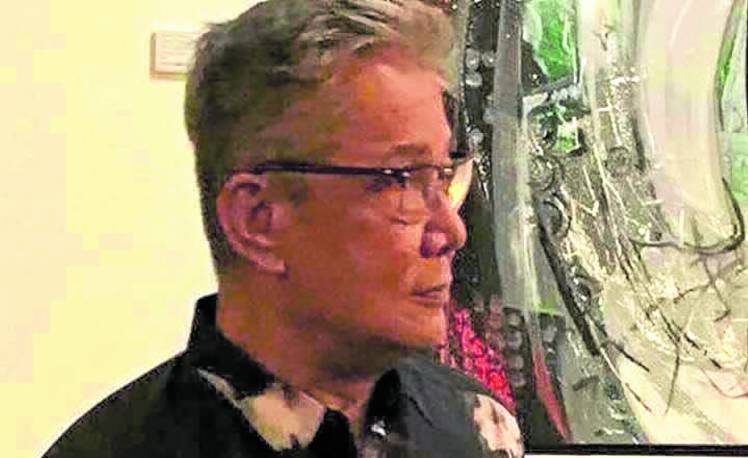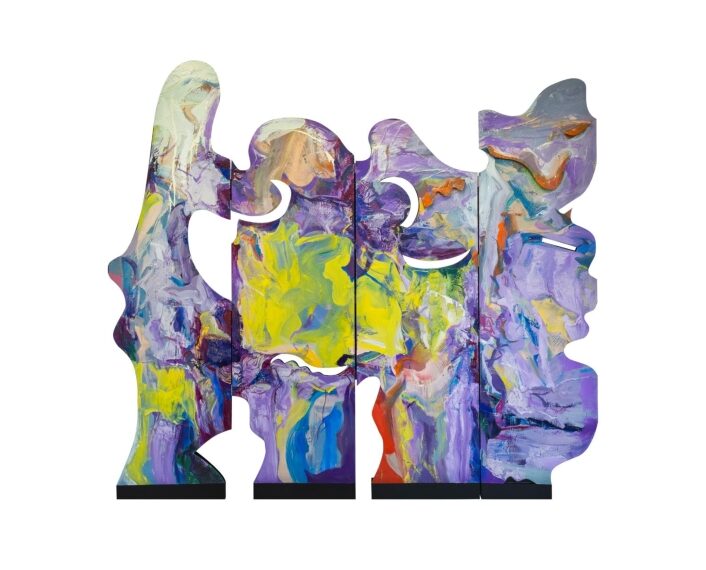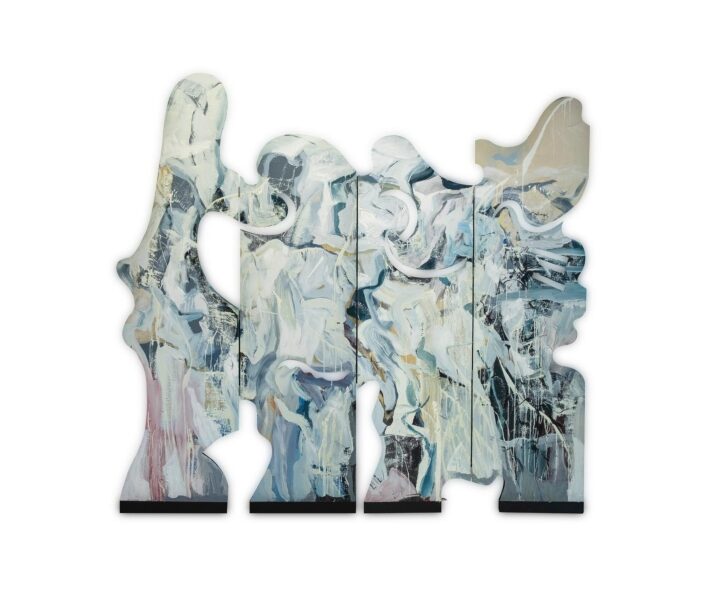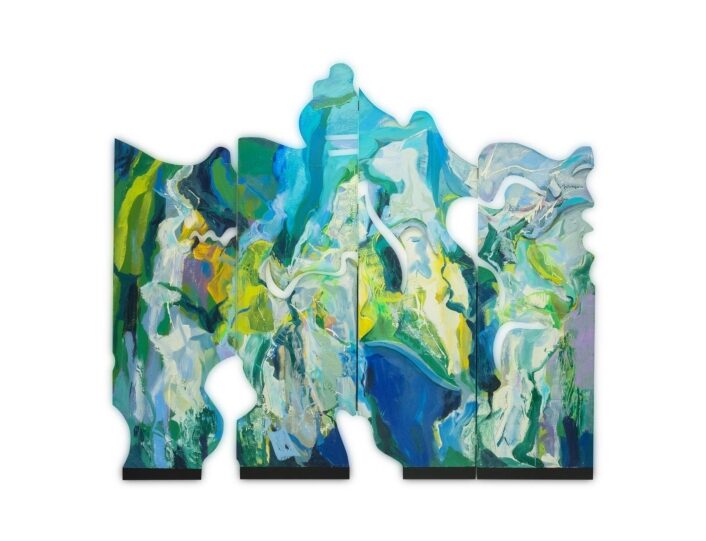
It is easy to see that in his “Wave Cadenza” series of paintings, Edwin Wilwayco reinforces Walter Pater’s famous dictum that “all art aspires to the condition of music.”
Indeed, in releasing the first series of works along that theme in an exhibit at Galerie Joaquin in 2022, Wilwayco was said to be rendering, in colors, textures and gestural sweeps, the physicality of Mozart’s sublime cadenzas, the virtuoso solo passages usually inserted by the Austrian prodigy into a movement of a concerto or an opera, usually toward the end.
A cadenza therefore is a fitting end to a musical piece, so that an opera aria by Mozart ends literally on a high note—and in the case of Wilwayco’s 2022 series, the oil-on-canvas works conclude in a crescendo or climax of sheer abstract expressionist flourish.
But is there really an end to a work of art? Going by Wilwayco releasing another batch of his “Wave Cadenza” series this year, albeit now as shaped screens and relief paintings, it appears not. This is not surprising since, as Pater’s declaration shows, while all art aspires to the condition of music, each piece of art “may be observed to pass into the condition of some other art, by what the German critics term as Anders-streben—a partial alienation from its own limitations, through which the arts are able, not indeed to supply the place of each other, but reciprocally to lend each other new forces.”

Herein lies most probably the versatility and continuing vitality of Wilwayco’s artmaking. His art has always found new energy (“new forces”) from the other arts such as sculpture and architecture (the screens and reliefs in “Birds of Paradise”), poetry (“In Nature’s Realms,” “Second Nature,” “Vines,” “Whispering Winds,” “Rivercircles,” which all could be taken as nature poetry), and of course music (“Homage to Vivaldi,” “Bach,” “Gluck,” “Scherzo” and “Excelsis,” “Benedictus” and “Gaudeamus,” the last troika from sacred music).
Even “Fractals” must have derived its energy from music, since fractal geometry, which is said to explain art lovers’ fascination with the drip technique of Jackson Pollock and the seemingly untrammeled if wild gestural verve of abstract expressionists like him, is physics-based, that is, determined by mathematics and music.
Therefore, “All art constantly aspires towards the condition of music,” music being fully formal, its form being “an end in itself: in short, totally abstract and spiritual.”
Sculptural screens

In “Wave Cadenza II,” Wilwayco updates the series by turning to sculptural screens and reliefs; since he’s striving for three-dimensionality, he’s also found new energy in architecture essentially because the new works will be there not only to fill up a space, but also to reconfigure it. Therefore, Wilwayco’s paintings become likewise sculptures-in-the-round, virtuoso architectural pieces that provide a sheer physical counterpoint to Mozart’s musical dramatics, a virtual sound architecture that limns and maps the music genius’ theatrical flourishes.
The four-paneled sculptural screens seek not only to mimic the most virtuoso passages of classical music, but recast the space around it. Its sinuous shapes can provide a sense of kinesis in an interior space that’s otherwise predictably laid out in very functional if quite staid terms. Standing if not spread out in fan-like arrangements, the “Wave Cadenza II” screens will surely not be mere standing décor pieces. They are artistic showcases that won’t keep still.
Wilwayco also carves out slits and interstices that, while allowing the breeze in, mimic the waves of musical notes and devices. The carved out pieces of wood are then used as relief devices in the screens, heightening the artworks’ three-dimensionality, their vivid expressionism.

Relief paintings
New in “Wave Cadenza II” are the relief paintings, in which Wilwayco replaces the old canvas frame with plywood boards in asymmetrical shapes like the screens, giving concrete depiction to the wavelike sound architecture of classical music. The asymmetrical shapes of the frame constitute a rhizomatic reinvention of the “plateau” that is the ordinary picture frame: They complement the powerful orchestral sweep of the artist’s strokes and strong play of vibrant and bold color arrangements on the board.
The rhizomatic frames, if we could call them that, are a first for Wilwayco. The relief paintings are obviously to be hung on the wall, but their relief and sculptural features disturb the usual order of things; they renovate if not introduce new contexts, new ways of viewing things.
“Rhizomatic thinking” is the philosophers Gilles Deleuze and Felix Guattari’s term for, at the cost of reductionism, thinking out of the box. Rhizome is a botanical term referring to the horizontal stem of tubers like ginger and potato usually growing underground that shoots out roots from multiple nodes, so that it would be hard to determine the source root.
This is contrasted with arborescent or the tree-like model of thinking that develops from root to trunk, branches and leaves.

Arborescent thinking, according to Deleuze and Guattari, is prey to the grand narratives of modernism and capitalism, while rhizomatic thinking seeks new ways of seeing and understanding. Thus, Wilwayco’s relief paintings with their asymmetric frames are rhizomatic art explorations.
Furthermore, Wilwayco’s recasting of the “Wave Cadenza” paintings as sculptures and reliefs, albeit with color, is quite striking. It dovetails with Pater’s thesis that each art form often encounters a “partial alienation from its own limitations,” so that the arts are able “reciprocally to lend each other new forces.” Pater further observes: “Thus, again, sculpture aspires out of the hard limitation of pure form towards color, or its equivalent; poetry also in many ways, finding guidance from the other arts, the analogy between a Greek tragedy and a work of Greek sculpture, between a sonnet and a relief… ”
Wilwayco has recently released “Wave Cadenza II” to mark his and Loby Frias’ wedding anniversary. The new series can be viewed privately at his studio in BF Homes, Parañaque City. It’s his first private exhibit. “This is my first attempt to do this in my career,” he said. “God bless my endeavor.”
Overall, “Wave Cadenza II” provides an exciting extension of Wilwayco’s accomplishments. They extend true art’s wonderful adventurings, wave upon counter-wave. —CONTRIBUTED
The “Wave Cadenza II” e-catalog can be viewed at heyzine.com/flip-book/d192ce5d9e.html. In-person viewing is by appointment; Call tel. 0906-5427281; email [email protected]; visit edwinwilwayco.com.








































